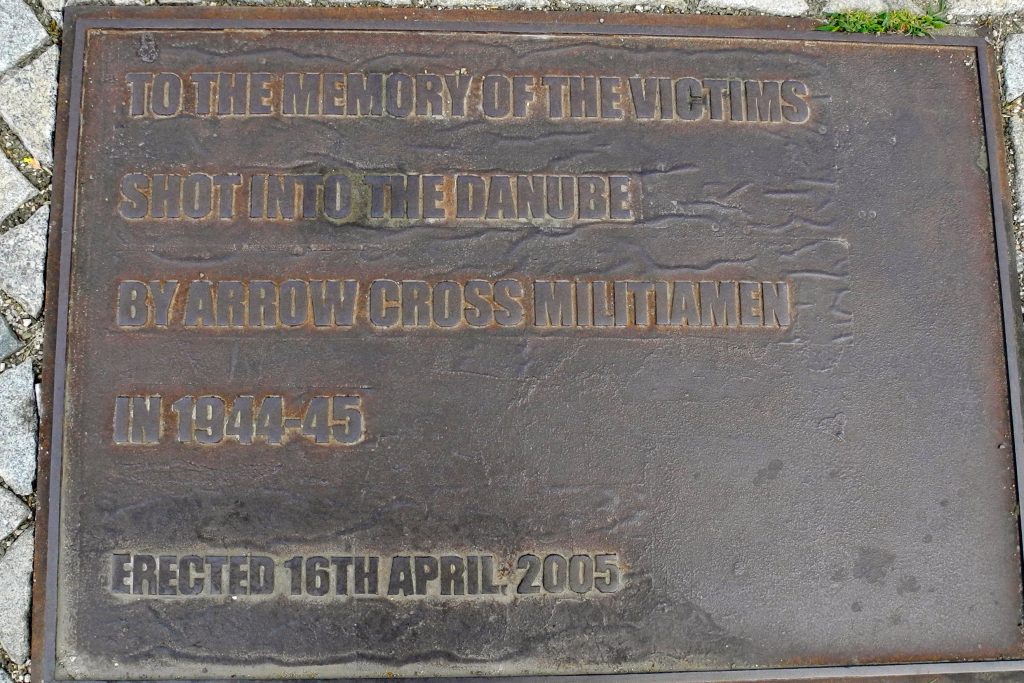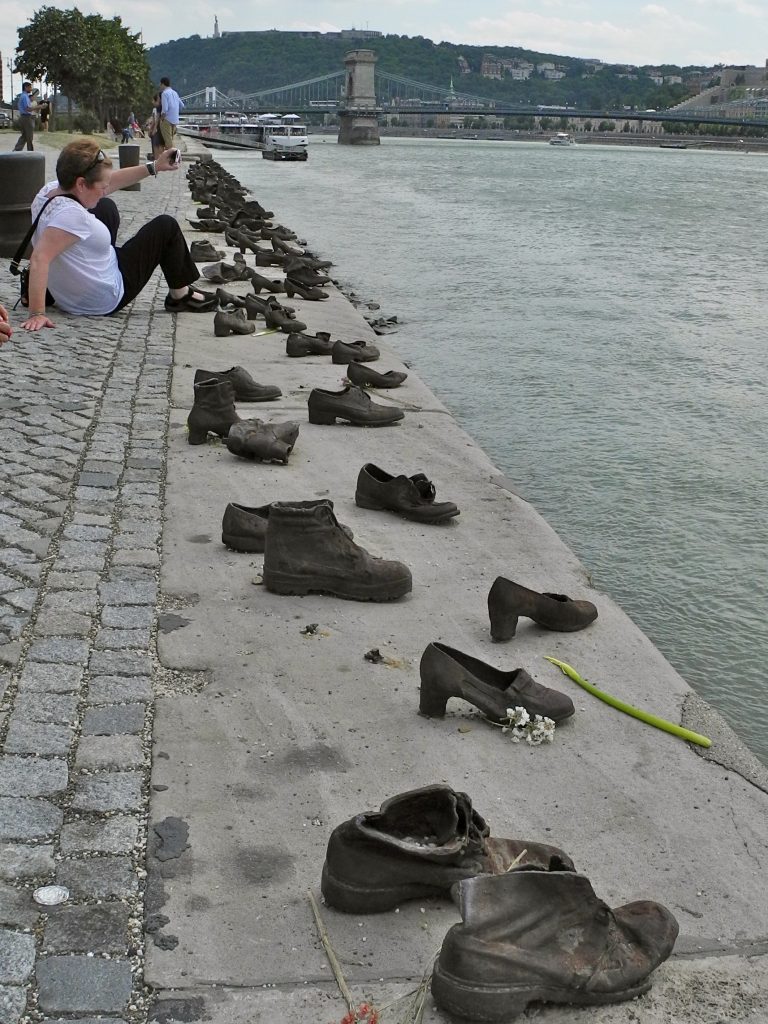
In Budapest on July 27, 2014, we happened upon a protest called Eleven Emlekmo Living Memorial. It was the 70th anniversary of the mass deportation of Hungary’s Jews to die in concentration camps.
Jews were told to remove their shoes and then shot by the Hungarian Arrow Cross and pushed into the river. As one of our guides said, “They disappeared.” Only their shoes remained behind.
We asked our Hungarian guide what it meant and she replied it was controversial – some believed the monument under construction in Freedom Square implied Hungary was also a victim of Nazi aggression during WWII while others thought Hungary should acknowledge its role in sending countless Jews to their deaths. Some admired Miklos Horthy, Hungary’s leader from 1920 to 1944, while others saw him as a Nazi collaborator and despised him.
But it was hardly controversial to those who had been quietly protesting for 75 days. Their makeshift memorial included photos, candles, letters, and stones (part of the Jewish tradition of leaving a stone when visiting a grave).
There were pleas to “never forget” the 6 million Jews who were murdered in the Holocaust.
We walked to the banks of the Danube – more shoes. This memorial was erected in 2005, and conceived by film director Can Togay. He created it on the east bank of the Danube River with sculptor Gyula Pauer to remind people that in 1944-45, Jews were told to remove their shoes and then shot by the Hungarian Arrow Cross and pushed into the river. As one of our guides said, “They disappeared.” Only their shoes remained behind. So many shoes.
I thought about the sweetness of a child’s shoe.
Here are the shoes my mother wore 90 years ago:
My baby shoes were bronzed 76 years ago:
My son’s saddle shoes were all the rage in the 70s:
One of my granddaughters wore these:
In my sheltered life growing up in a suburb of Detroit, there was not much conversation about the Holocaust. Perhaps the late 1950s was still too soon to speak openly about such things. So, I struggled to understand how people, who would have included me had my grandparents not decided to immigrate to America, were exterminated just because they were Jewish. I had nightmares about being sent to a concentration camp. It was beyond my comprehension and none of the adults in my life wanted to discuss what had happened and, more importantly, why.
I wonder if, like America in the 1950s, Eastern Europe was not yet ready for this difficult conversation, even by 2014. In Vienna, our young German-born guide seemed genuinely sorry about what happened. But she was also not able to answer some of our basic questions about current thinking in Austria regarding its role in the Holocaust. On the other hand, our Jewish guide at the Budapest Jewish Museum shared that Hungarians focused on their suffering at the end of WWII and during the Soviet occupation, but tended to underestimate their role in deporting and exterminating Jews during WWII. The same held true in Prague. Our kind, grandmotherly Czech guide, whose family had hidden a Jewish daughter-in-law at great peril during WWII, told story after story of hardships and cruelty at the hands of the Russians. Going to Terezin was painful for her, and she avoided taking people there until recently. But she also shared it that Czech children rarely came there to visit and regretted that they didn’t learn much about the Holocaust in school.
After visiting restored synagogues in Budapest and Prague, after visiting the monument against war and fascism in Vienna, after seeing countless graves covered with stones, after looking at far too many lists of names of people whose date of death was 1944, it was the shoes that hit me like a punch in the gut. It is only luck that separates me from those who perished. My mother’s shoes could have become part of the Prague Living Memorial. No bronzed baby shoes, saddle shoes, or sweet white Mary Jane shoes would have followed for our family.
Life is as fragile and precious as a child’s shoe. And the current generation of children needs to know that such evil happened. This is the only way we have a prayer that it will not happen again.
Boomer. Educator. Advocate. Eclectic topics: grandkids, special needs, values, aging, loss, & whatever. Author: Terribly Strange and Wonderfully Real.







Beautifully written, painful story Laurie.
I’m now thinking of my story about our impactful visit to the Yad Vashem museum in Israel and our tears she’d there.
https://www.myretrospect.com/stories/vad-vashem/
Tried to read your link but got a 404 error. There are really no words to capture the horror of the Holocaust.
That was a powerful and meaningful artistic intervention in the environment of the city. And yours was an eloquent, well-told story. I just about teared up when you called back the shoes you had previously described (and included in the illustrations), and with some slight changes in your family’s history, there could have been no such shoes at all. Somber but beautiful thoughts.
I have thought about how lucky I was to exist given what happened to so many who did not leave Europe in time to escape their fate at the hands of the Nazis. And I fear we could easily go back to those times if the wrong people are running things in our country and the world.
I cried reading this Laurie. What a profound commentary on the most horrific crime of mankind’s inhumanity to man. The shoes also did me in. Seeing so many, knowing the fate of all these innocent, helpless people and their children, really hit me hard. I envisioned the babes in your mom’s shoes. The pictures you included and your raw, honest, heartbreaking portrayal of this senseless atrocity Is something (with your permission) I would like to copy to share with family and friends. EVERYONE should know this!
Feel free to share. I fear it is forgotten by the young people, especially in places where it is not even taught.
This is a moving and beautiful story, Laurie. And of course you are completely correct. Those bronze baby shoes could have just as easily been part of that memorial by the Danube. “There but for the grace of God go I…” And of course, if we do not learn history, we are doomed to repeat it (says Santayana).
It is infuriating and frightening that elements in our country are trying to erase or rewrite history even as I write this. We cannot let them succeed!
I now don’t remember how I met him, but the summer before I went off to college, I dated an older man who played the cello. My parents didn’t approve because he was about 4 or 5 years older than I was. He lived in Oak Park and took me home to meet his parents. I noticed the tatooed numbers on their arms (it was summer and they wore short sleeves). They explained they were Holocaust survivors. I had never met any. They were not ashamed, but also didn’t go into any details. I was polite, but didn’t ask any further questions and Joel and I went out on our date, but the impression has lasted these 53+ years. We must never forget!
I wonder of the guy was the Joel I knew in high school. You are so right, Betsy. I feel lucky that my fmily left Lithuania when they did. You express how I feel so articulately.
Laurie: The Holocaust though the portrayal of shoes avidly increases its horrors. Your memorable memoir should be give a wide public exposure.
Your piece moved me to envision future anthropologists burrowing through the desert sands along the Rio Grande to collect shoes, toys, clothing, and backpacks from the unidentified immigrants died in their search for freedom. Contemporaneously , historical osteologist’s with collect DNA on behalf of Ancestry DNA efforts to unite survivors with their ancestors.
The historian in me links the perpetrators of the Protocols the Elders of Zion who charged Jews with spreading disease and endangering Western civilization with today’s white nationalists who brazenly claim that hordes of immigrants are engaging in the criminal behaviors of crime, drugs, and child abuse with the aim of overpowering the white American population.
So true, Richard. I don’t know if you ever watched the sometimes cringe-worthy Curb Your Enthusiasm. In one episode last season, Larry David somehow loses his shoes before a gala at the Holocaust Museum and takes a pair from a display of shoes of victims. Not at all funny.
Larry David seems to delight in making people uncomfortable. Many of the greatest comics did and do. Which is a legitimate way to make people both laugh and think, but definitely carries the danger of crossing a line into unfunny, even disrespectful (to some) behavior.
I agree. Many of my friends won’t watch him because they find him to be offensive. Usually I laugh at his antics, but the shoe thing did cross a line for me.
The shoes capture the horror of the Holocaust in a way that expresses the humanity of those executed. These were not faceless people–every one had a story, a life, loved ones, a future snuffed out by senseless murder. It still stuns me that there can be such a thing a a Holocaust denier, but of course one of the first things a repressive regime does is to destroy history. I wish we weren’t seeing that today as well. Let us never forget, and teach our children well.
So true, Khati. To forget or deny history (think Florida) is a sure path to repeating it. I fear too many have forgotten the Holocaust. See Richard’s comment below.
Echoing Laurie’s comment about there being no words that can fully express certain tragedies, the shoes make an impact that words never could. Other memorials come to mind; the empty pools at the WTC memorial site, and the endless crosses (and more than a few Jewish stars) in their peaceful, ordered rows at the American Cemetery in Normandy, France. I have seen the latter, and stood on nearby Omaha beach. It shook me to the core of my being.
As an aside, whenever I see baby shoes, I think of a “six word story” often attributed to Hemingway, although the earliest known example is from 1906:
“For sale: baby shoes, never worn.”
OMG, that 6 word story is so powerfully sad.